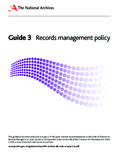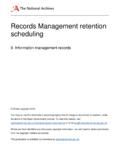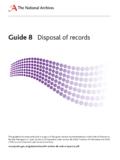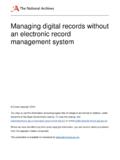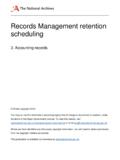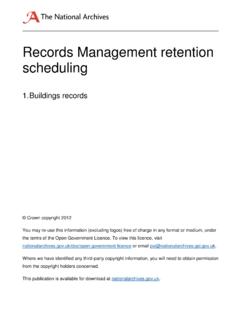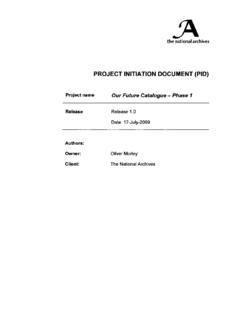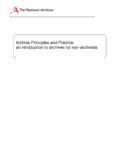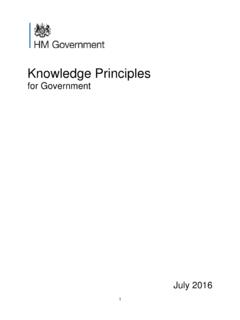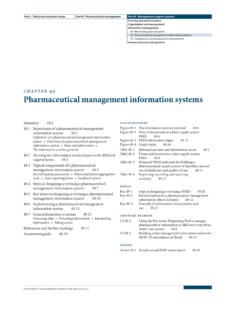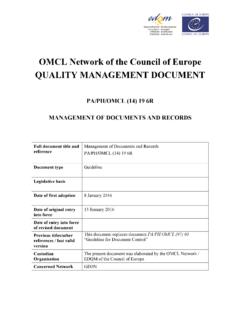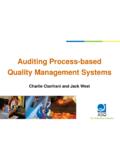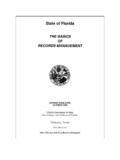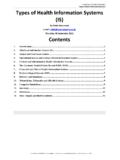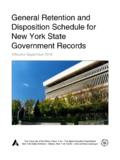Transcription of Records Management Retention Scheduling
1 Records Management Retention Scheduling 2. Employee personnel Records March 2006 Crown copyright 2011 You may re-use this information (excluding logos) free of charge in any format or medium, under the terms of the Open Government Licence. To view this licence, visit or email Where we have identified any third-party copyright information , you will need to obtain permission from the copyright holders concerned. This publication is available for download at Records Management Retention Scheduling 2. Employee personnel Records 19 January 2012 Page 2 of 14 Contents 1 Background .. 2 2 Scope and nature of the Records .. 4 3 Data Protection Act 1998 .. 5 4 Retention principles .. 7 Schedule of personnel Records Dretention period .. 9 Document description - Employment and career .. 9 Retention period .. 9 Document description - Health.
2 10 Retention period ..10 Document description - Health ..11 Retention period ..11 Document description - Personal ..11 Retention period ..11 Document description - Security ..11 Retention period ..11 Document description - Pay and pension ..11 Retention period ..11 5 Enquiries and further information ..13 1 Background For many years the recommended Retention period for most employee personnel Records (generally known as P (personnel) Files) was 85 years from the date of birth or five years after death, whichever was later. Requirements of the Principal Civil Service Pension Scheme (PCSPS) were the principal determinant of these Retention periods. Dear Establishment Officer letter DEO (PM) 98/1, dated 31 March 1998, issued jointly by the Cabinet Office and the Public record Office (PRO), offered revised guidance to government departments and agencies about PCSPS requirements.
3 This revised guidance, which replaced the earlier advice, gave Principal Establishment and Finance Officers (PEFO) much broader discretion over the Retention of Records , including discretion to substitute Retention to age 72 in place of age 85. Records Management Retention Scheduling 2. Employee personnel Records 19 January 2012 Page 3 of 14 In November 1999 a Working Group on the Application of the Data Protection Act 1998 to Civil Service Personnel Records , chaired by the Cabinet Office, issued new guidance to PEFOs. This guidance recommended that pension Records should be based around age 72 (or five years after the last action if later). However, circumstances have changed: people are living longer, they have the right to defer taking their pensions and they are more likely to enter new family relationships. The pension section of this publication has been amended to reflect this, but it remains for individual PCSPS employers, having regard to DEO (PM) 98/1, to determine whether to accept age 72 rather than a Retention point of age 85 or any other period.
4 In forming a judgement it is important that departments should note that where relevant papers are destroyed and a claim for pension benefits is subsequently accepted without documentary evidence to support the claim, the costs involved will have to be met from departmental funds, not from the Civil Superannuation Vote. Many non-pension Records need not be kept for the same period; these are detailed in the model schedule at section 4. The National Archives does not generally require any civil service P Files for permanent preservation, but may very occasionally accession those of very famous/notorious employees. Selected departmental working files will usually provide adequate evidence about those who achieve fame or notoriety in their work. For general information on the compilation of Retention schedules, see Disposal Scheduling (The National Archives, 2004).
5 This guidance is aimed at Records managers and Human Resources managers in government. Any individual departmental guidance should be endorsed by both parties. Records Management Retention Scheduling 2. Employee personnel Records 19 January 2012 Page 4 of 14 2 Scope and nature of the Records This guidance covers the information held on individuals, commonly called P Files. Records which document the broader work of Human Resources section, for example policies, that provide the foundation for actions which are applied to individual employees, are part of the registered file collection and are governed by First and Second Review criteria or Operational Selection Policies (see also sections and ). The Records held in P Files cover six broad areas: Employment and Career Health Pay Pension Welfare Security All five areas of information may not be held on one central file, but may be retained as separate collections.
6 This may be to facilitate disposal, to safeguard sensitive information , for example Welfare papers, or because of physical location. Employee personnel Records are also increasingly held in electronic databases. The Retention of information so held should be the same as that for the equivalent paper Records . The difficulty encountered by organisations will centre round their physical Retention , including migration or emulation when software systems are changed or upgraded. The National Archives has issued guidance on the sustainability of digital information ; this guidance is constantly under review and being updated as technology and procedures develop. Records Management Retention Scheduling 2. Employee personnel Records 19 January 2012 Page 5 of 14 See Records may also be in hybrid collections of paper and electronic media or some organisations might transfer paper Records on to microform.
7 Departments will need to decide whether to operate a hybrid collection and retain Records in their original media or to rationalise into one media. Costs will often be a deciding factor. In instances where copies are made it will not always be necessary to keep signed original documents (for example, death benefit nomination form or pension added years). Legible copies of originals transferred to other media will usually be as effective as the originals in enabling an organisation to consider and, if necessary, dispute a case of non-compliance or complaint brought by a member of staff. In all such cases confirmation must be sought from legal staff. See also the Code of practice for legal admissibility and evidential weight of information stored electronically (PD 0008, British Standards Institute). 3 Data Protection Act 1998 The Data Protection Act 1998 is fully effective, with the exception of the October 2007 exemptions, for computerised and manual departmental P Files.
8 The Act requires those holding personal data to comply with eight data protection principles, to register with the information Commissioner, and to allow people to access and, if necessary, to correct data that relates to them. Records Management Retention Scheduling 2. Employee personnel Records 19 January 2012 Page 6 of 14 Part II of the Act gives the data subject (the person to whom the data relates) a number of rights, including the right to be told which data are held about them, why they are held, where they came from and where they may be sent. Unlike the 1984 Act, the current Data Protection Act requires compliance with the principles by all data controllers, even when they are exempt from notification. Definitions in the Act for data and personal data represent a significant extension of the data protection regime introduced by the Data Protection Act 1984.
9 Data now include information that is in manual Records , which may be paper, microform or other non-computer form. Data that are part of a relevant filing system or intended to be included in such a system fall within the scope of the Act. A relevant filing system is: Civil Service policy towards subject access to manual data is that there should be an orderly transition to maximum possible subject access. Guidance to departments on this and other points is given in the Cabinet Office letter of 26 November 1999 issued to PDG (Main), Small Departments and Agency Chief Executives. Detailed information on compliance with the Data Protection Act 1998 can be obtained from: The Data Protection Act 1998: Legal Guidance (Office of the information Commissioner) Guide to the Practical Implementation of the Data Protection Act 1998 (PD0012; British Standards Institute 1999) Code of Practice for Archivists and Records Managers under section 51(4) of the Data any set of information relating to individuals which is structured either by reference to individuals or by reference to criteria relating to individuals, in such a way that specific information relating to a particular individual is readily accessible.
10 Records Management Retention Scheduling 2. Employee personnel Records 19 January 2012 Page 7 of 14 Protection Act 1998 (The National Archives, Society of Archivists and Records Management Society, 2007) See also the Office of the information Commissioner s web site at 4 Retention principles Because of the changed circumstances mentioned in , documents bearing on pension entitlement should generally be kept for 100 years from date of birth. However there are some Records which, although having a bearing on pension entitlement, appear in the schedule below in another section. This is because these are Records which are built up over time during employment and have relevance in more than one section of the schedule. For example, record of service abroad is compiled initially as part of employment and career but is ultimately required for the pension award calculation.
